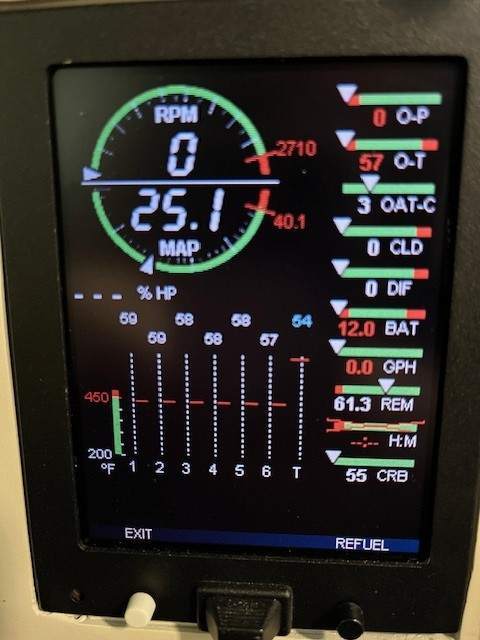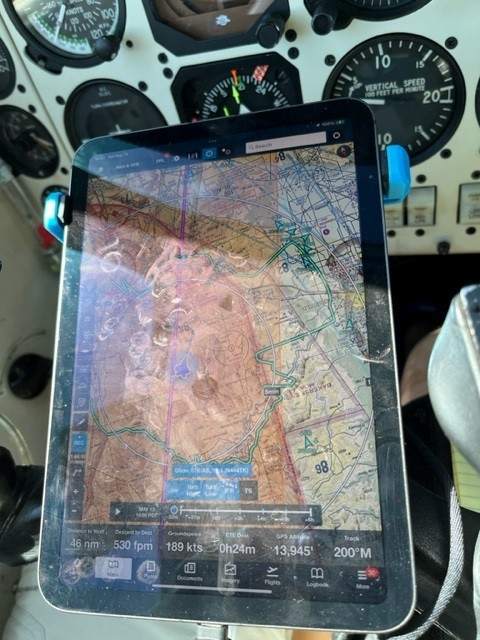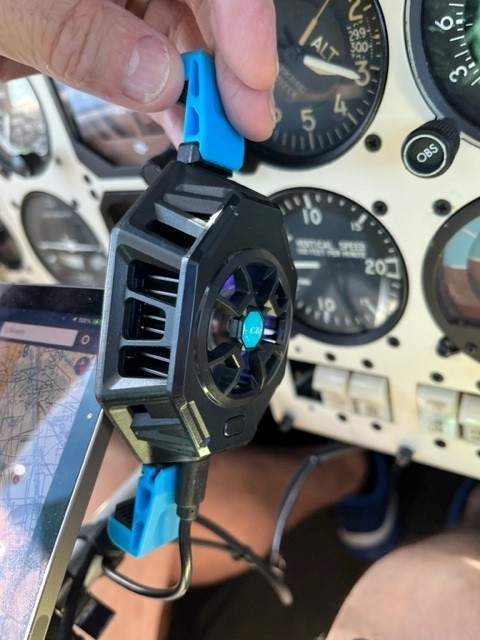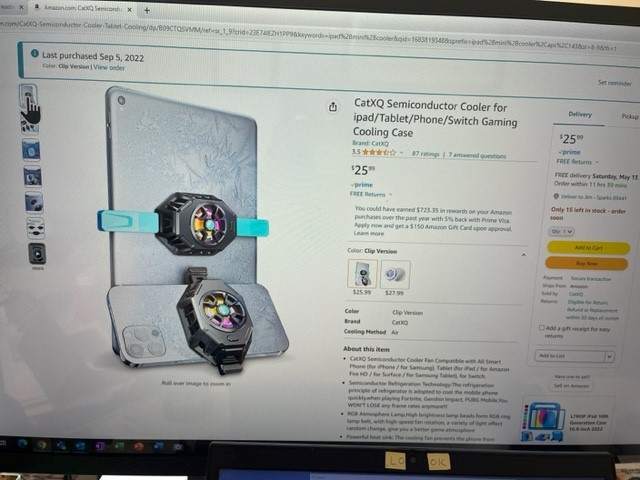-
Posts
159 -
Joined
-
Last visited
Content Type
Profiles
Forums
Blogs
Gallery
Downloads
Media Demo
Events
Everything posted by Jim F
-
Hi Skip, Four or more years ago, I saw someone post here a pic of a Lycoming with a crack in the case right under the lifting eye. At the time, I thought the only possible reason for the crack was jacking the nose of the aircraft with the engine lifting eye. Jim
-
Hi Wingover, I don't have the part number but you can measure the tube OD and the opening in the baffling. Then search the web or a hardware store. When you get the new grommet just cut and roll it in place. Jim
-
Agreed Ross, just my 2 cents
-
Hi Shadrach, I have seen problems with CHT cooling and the only thing found on inspection was detached seal from the aluminum baffle. Reattached and the CHT came down. My take away was that the airflow is dynamic inside the cowl during flight and must have vibrated or folded over. Back in the day I replaced cowl seals two times a week on average. I have said before in other threads, I look at the baffling and cowl seal like a water radiator, no air lead are expectable.
-
-
There should be a rubber grommet in the area in red, one to seal the air gap and two to keep from chaffing through the line. jim
-
As @N201MKTurbo & EricJ its about the how the seals - seal. Think about every space that air can leak as a problem that must be fixed. The only way to cool the cylinder is to have air flow down through the cylinder fins. 1) You are missing all the lower front cowl seals. 2) Cyl #1 looks like you only have a front and back pop rivets and you are missing the pop rivets in the middle. 3) The prop gov hard line in missing a grommet. 4) the back seal is vertical, you normally would like to see a bend forward so when the upper cowl is put on the seal faces forward and the high pressure above the engine pushes the seal on the cowl. If any seal folds over toward the low pressure area you will lose a huge amount of cooling air. When you put on the lower cowl on make sure all the lower seals are in the correct direction, think high pressure low pressure. When you put on the top cowl look in with a flash light and make sure all seals face the correct direction, forward and inboard.
-
You can reinstall the caliper on the hydraulic line and step on the brake pedal. It will push the puck out. Its going to make a mess. Once the puck pops our removed the hydraulic line and cap immediately. You don't want air in the system. When you put it back together add some hyd fluid to the caliper and slide the puck in hold the fitting at the top. Push the puck in and keep tapping the housing. The idea is to make sure there is NO air in the puck. You will need the puck to still have about an 1/8 of an inch to go till flush. Reattach the brake line loosely and press the puck in till flush while wiggling the caliper to brake loose any air bubbles and tighten the fitting. If done properly you should not need to bleed the brakes.
-
-

Any legal reason a USB charger has to be certified?
Jim F replied to ragedracer1977's topic in General Mooney Talk
A friend installed a tractor LED as a landing light, same PAR36 so should be good, right. After he departed a private field with radio call outs and then called ATC to do some practice approaches he found the he was always Tx on both radios and any frequency, NORDO. He found that when he turned the landing light off everything was good. Yes tractor LED are cheaper, No they don't work if you want to use your radio. Oh course you are totally legally in using a cigarette lighter USB charger. kind of relevant -
When I was in a non heated hangar I used a trouble light stuffed up the cowl flap opening and a silver lined bubble wrap cover that i made to cover the engine. After a flight i would stuff the trouble light( with an incandescent 75watt bulb) up the cowl flap and rest it below the oil sump. I left it on 100% of the time. Even when it was <10F in Reno over night I would power up the master and check the engine temp on the JPI. The engine was always above 50F. In a pinch once when I got the plane stuck over night below freezing and no pre-heat available on the way into the airport I stopped by a hardware store and picked up an aluminum dryer duct. I pulled the rental car up close to the plane and connected the dryer duct to the car tail pipe and stuffed the pipe in the cowl flap with the oil door open. It took about 30 min to get the cylinder temps up and I pulled the prop through to see how she felt. Jim
-
Interesting, thank you
-
Hi Shadrach, Do know the procedure to clean out the lines, master cylinders, and calipers of 5606. Thanks Jim
-

Engine won't run on the Left Magneto
Jim F replied to Adverseyaw0317's topic in Modern Mooney Discussion
On your dual mag, do you have 2 P-leads on the left side(shower of sparks) and one on the right? Or when you pull the prop through in the normal direction do you hear a loud clunk like a deadbolt lock(Impulse coupling)? My guess is you have a shower of sparks and that kind of limits your troubleshooting options. From your symptoms I would bet that your left starting points(shower of sparks) are working and your left mag points are not set correctly. When you turn your key to energize your starter, it grounds both LH and RH points and only the LH start points operate. When it kicks and you go to both then both the LH and RH points operate as normal. This is so the normal points don't fire the spark plugs during start at 20 degrees BTDC and kick back. If you have a impulse coupling your left mag is most likely bad and your starting on your right. To prove the Mag/start switch is working correctly: Caution you are moving the prop with the mags HOT if there is fuel in the cylinder the prop can swing through and hurt you. 1) You can test your ignition switch by putting a Mag timing buzz box on the P leads(if studs) mag switch to both, move the prop to get both buzz box lights to come one. Then sit in the pilot seat, master off, wiggle the switch in the off position to see if the buzz box light change, then right and the right light should change, wiggle the key, then go to left, wiggle the key, move fully clock wise to the start circuit(mast off) and wiggle again. If you have P-lead caps you can remove both normal caps and connect the buzz box clips to the p-leads and run the same test above. -
+2 for Airspeed Insurance @Parker_Woodruff
-
I used bifocals for 5 years and when I first got fitted my optometrist had me sit in the plane and make a mark with a sharpie where the glare shield sight line hit my glasses. Then after 5 years in a moment of vanity I switched to non bifocal contacts and I love the depth perception. Now I use contacts for distance and Method Seven sunglasses with bifocal reading glasses. Without a doubt Method Seven( As Danb mentioned ) makes the best pilot eye protection that I have ever used. You can measure the distance from your eyes to the panel and have your optometrist measure the magnification needed for your readers at the actual measurement . Method Seven makes sunglass in different strengths so you can cut down on the glare and add the bifocal readers. Jim
-
Hi Al, Sorry that was a typo, GPH gallons per hour. My GB does not have an intercooler so my max MP is 40inchs. What ever your paperwork says on max MP that's where you should see the max FF 25.7GPH
-
Just to add a bit to what the others have said. Do you have a engine monitor? if not you should An engine monitor would help isolate what event started the engine shutdown. to troubleshoot, I would verify the fuel flows, but first before I ever touch fuel flows, I pressurize the intake and exhaust system and spray soapy water to find and fix any leaks. I also clean the injectors before checking or adjusting fuel flows because the injector nozzles are the pressure restriction. Our engines fuel injection system is a fuel pump with mixture adjustment, and aneroid to automatically adjust fuel based on upper deck pressure. The throttle body has some brass plates with orifices to vary the actual fuel flow. Doing the pre-adjustment set up that i discussed and a proper FF adjustment will give you a base line for the fuel system being set correctly. Remember that with your added intercooler the max MP is ~36in. Non intercooled max is 40in and with intercooler ~36in is the same air charge just a denser and cooler air. At max MP your fuel flow should be 24.7GPM + 1gpm(a recommendation from Savvy). This additional 1GPM is the best recommendation that i have seen for our TSIO-360 engines. A little extra fuel and my engine runs cool at full power.
-
Here is my fix for Ipad overheating. Last weekend I had a 2 hour flight with the sun on my mini for the entire flight. No overheating. This is a Peltier cooling unit(cooing from a integrated circuit?
-

At Spruce Creek right now....
Jim F replied to Jim Peace's topic in Mooney Safety & Accident Discussion
I totally agree. A couple years back there was a discussion on a 231 that was not making power and hit a levee. After following the discussion on MS I started the following. I to fly off a short strip (1800ft 4CA2) so I marked the mid point of the runway with mid point marks and now I must be above 63MPH(My margin number) by mid point. On the roll I get takeoff power, verify airspeed is alive, look for all six cylinders working, 100% power, >63MPH by the mid point. Jim -
I agree
-
My 1981 M20K has them and i am stock. I would guess they are for fuel flow setup and adjustment so you can close the door or not feed fuel line through the wing window. make sure you have caps on one side or you have a CO leak.
-
You still have the protective installation plastic on the display. Your display will look much clearer when removed.
-
I installed my 830 oil temp probe on the front left oil galley right next to the prop governor.
-
What was done to the engine at the annual? I would pop the cowl and do a look-see. Look at the baffle seal to make sure its laying correctly and there is no blockage on top of the oil cooler. Your oil cooler is in the back of the engine on the pilots side, a rag or birds nest can easily cause the high temp which will cause low pressure.










